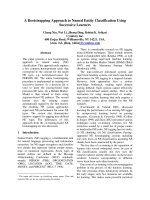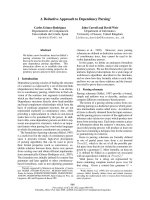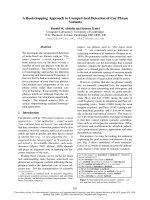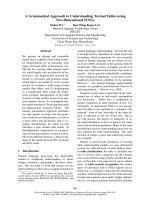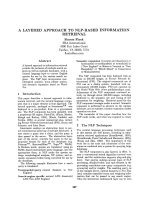Báo cáo toán học: "A semigroup approach to wreath-product extensions of Solomon’s descent algebras" pdf
Bạn đang xem bản rút gọn của tài liệu. Xem và tải ngay bản đầy đủ của tài liệu tại đây (120.1 KB, 9 trang )
A semigroup approach to wreath-product extensions
of Solomon’s descent algebras
Samuel K. Hsiao
Mathematics Program
Bard College
Annandale-on-Hudson, NY, 12504
Submitted: Aug 15, 2008; Accepted: Jan 27, 2009; Published: Feb 4, 2009
Mathematics Subject Classification: 05E99; 16S34; 20M25
Abstract
There is a well-known combinatorial model, based on ordered set partitions, of
the semigroup of faces of the braid arrangement. We generalize this model to obtain
a semigroup F
G
n
associated with G S
n
, the wreath product of the symmetric group
S
n
with an arbitrary group G. Techniques of Bidigare and Brown are adapted to
construct an anti-homomorphism from the S
n
-invariant subalgebra of the semigroup
algebra of F
G
n
into the group algebra of G S
n
. The colored descent algebras of
Mantaci and Reutenauer are obtained as homomorphic images when G is abelian.
1 Introduction
A celebrated result of Solomon [27] reveals the existence of an intriguing subalgebra,
known as the descent algebra, inside the group algebra of any finite Coxeter group. In
the case of the symmetric group, the descent algebra has a particularly simple combi-
natorial interpretation in terms of descent sets of permutations. This interpretation is
an important ingredient in numerous extensions, applications, and further investigations
[13, 5, 12, 18, 22]. A fitting example, one that is central to this paper, is Mantaci and
Reutenauer’s construction of “colored” descent algebras [18] via wreath-product exten-
sions of the symmetric group. Their work highlights the vibrant interest in developing
colored versions of combinatorial tools associated with the symmetric group. Along these
lines, a significant development is Baumann and Hohlweg’s [4] far-reaching descent the-
ory for wreath products, in which the functorial nature of the colored constructions are
brought to light. Continuing in this vain, Bergeron and Hohlweg [6] provide a unifiying
generalization of a number of colored constructions in the literature and discover new
colored algebraic structures using their theory. Also part of this circle of ideas is Novelli
and Thibon’s [20, 21] generalization of free quasisymmetric functions to the context of
the electronic journal of combinatorics 16 (2009), #R21 1
colored permutations, as well as Petersen and this author’s [16] use of colored posets to
study the Hopf algebraic structure of Poirier’s colored quasisymmetric functions [24]. All
of these works in some sense expand on the theme of colored descent algebras, and are
thus part of a story began by Mantaci and Reutenauer.
This paper completes another part of the colored story by offering a wreath-product
version of a semigroup theoretic approach to understanding to the descent algebra, an
approach that goes back to the work of Tits [30, 31]. In his appendix to Solomon’s paper
[27, 31], Tits uses a semigroup structure on the faces of a Coxeter complex (which he
states in terms of projection maps [30]) to prove and give geometric interpretations of
Solomon’s results. Building on Tits’s ideas, Bidigare [7] explains how the descent algebra
of the symmetric group S
n
can be recovered from the invariants of an S
n
-action on the
semigroup of faces of the braid arrangement, or equivalently, faces of the Coxeter complex
of S
n
. We will denote this semigroup by F
n
. Our goal is to generalize Bidigare’s approach
to G S
n
, the wreath product of S
n
with an arbitrary finite group G.
We learned of Bigidare’s (unpublished) result through Brown’s paper [9, Theorem 7], in
which a geometric version of Bidigare’s proof is given. While our proof is purely algebraic,
it has Brown’s argument at its core. The first step in our approach is to take a group G
and define a semigroup F
G
n
, which can be viewed as a wreath-product version of the face
semigroup F
n
. Our semigroup is defined in terms of ordered set partitions of {1, 2, . . . , n}
decorated with elements of G, generalizing the combinatorial definition of F
n
. Unlike the
face semigroup of the braid arrangement (or of a hyperplane arrangement in general),
elements of F
G
n
are not necessarily idempotent. Instead, they satisfy the identities
x
|G|+1
= x and xyx
|G|
= xy (1)
for all x, y ∈ F
G
n
. When |G| = 1 these identities define left regular bands. If |G| is
an arbitrary positive integer, a finite semigroup that satisfies (1) is an example of a left
regular band of groups. Left regular bands of groups belong to the class of completely
regular semigroups. See for example [23].
The next step in our approach is to introduce an S
n
-action on the semigroup al-
gebra ZF
G
n
, for which the invariant subalgebra (ZF
G
n
)
S
n
has a basis (σ
α
) indexed by
G-compositions (which generalize the notion of descent set). The group algebra Z[G S
n
]
also contains a Z-submodule, defined analogously to Solomon’s descent algebra, having a
natural basis (X
α
) indexed by G-compositions.
Our main result, a wreath-product extension of Bidigare’s theorem in the case of the
symmetric group, is as follows:
Theorem 1. The Z-module map f : (ZF
G
n
)
S
n
→ Z[G S
n
] given by f(σ
α
) = X
α
is an
injective anti-homomorphism of algebras.
It follows that the image of f is a subalgebra of Z[G S
n
]. For abelian groups G these
subalgebras turn out to be the generalized descent algebras introduced by Mantaci and
Reutenauer [18]. For arbitrary groups G these algebras appear in the works of Novelli
and Thibon [20] and Baumann and Hohlweg [4]. Also, see [2, 3, 15, 8] for works that
make connections to the important special case G = Z/2Z.
the electronic journal of combinatorics 16 (2009), #R21 2
Our approach, in addition to providing an elementary and concise route to understand-
ing Mantaci and Reutenauer’s colored descent algebras, offers a combinatorial framework
in which to explore or apply wreath-product versions of results on left regular bands. As
a case in point, in a recent paper Margolis and Steinberg [19] develop a homology theory
for the algebra of a regular semigroup, allowing them to compute the quiver of a left
regular band of groups (extending Saliola’s result for left regular bands [25, 26]), and as
an application they explicitly describe the quiver of the semigroup algebra ZF
G
n
. Another
direction in which to look for colored versions is Brown’s theory of Markov chains on left
regular bands [9, 10]. Steinberg [28, 29] has already generalized the spectral computation
in [9] to semigroups with basic algebras, which include the semigroup F
G
n
. A related
area that remains to be fully investigated is a wreath-product extension of the work of
Hersh and this author [14] on interpreting endomorphisms of quasisymmetric functions
as Markov chains; much of the machinery is already in place for such an investigation
[6, 16]. Let us also mention the monograph by Aguiar and Mahajan [1], who study the
relationships between various combinatorial Hopf algebras through the lens of Coxeter
groups and their associated face semigroups. Actually they work at the level of left reg-
ular bands. The functorial nature of many of the colored constructions of Baumann and
Hohlweg [4] and Bergeron and Hohlweg [6] gives hope of extending the tools in [1] via
wreath products to a broader class of semigroups, which would certainly include F
G
n
but
could perhaps be extended to left regular bands of groups or beyond.
Throughout this paper we assume that G is a finite group and denote its identity
element by 1
G
. However, it should be noted that the definitions of our main objects of
study, namely F
G
n
, (F
G
n
)
S
n
, G S
n
, and D(G S
n
), still make sense when G is an infinite
group, or even just a semigroup with identity, that is, a monoid. For such G, Theorem 1
still holds, but Formulas (1) might fail.
2 Preliminaries
2.1 The semigroup of ordered G-partitions
Fix a positive integer n, and let [n] = {1, 2, . . . , n}. An ordered partition (also called a
block partition) of [n] is a tuple (B
1
, . . . , B
k
) of nonempty pairwise disjoint sets whose
union is [n].
An ordered G-partition of [n] is a tuple ((B
1
, g
1
), . . . , (B
k
, g
k
)) such that (B
1
, . . . , B
k
)
is an ordered partition of [n] and g
i
∈ G for all i ∈ [k].
Let F
G
n
denote the set of ordered G-partitions of [n]. Define multiplication in F
G
n
by
((B
1
, g
1
), . . . , (B
k
, g
k
))((C
1
, h
1
), . . ., (C
, h
)) =
((B
1
∩ C
1
, h
1
g
1
), . . . , (B
1
∩ C
, h
g
1
),
(B
2
∩ C
1
, h
1
g
2
), . . . , (B
2
∩ C
, h
g
2
),
.
.
.
(B
k
∩ C
1
, h
1
g
k
), . . ., (B
k
∩ C
, h
g
k
))
where empty intersections are omitted. This gives F
G
n
the structure of a semigroup (with
the electronic journal of combinatorics 16 (2009), #R21 3
identity element (([n], 1
G
))) satisfying Formulas (1). If |G| = 1 then F
G
n
is isomorphic to
the face semigroup of the braid arrangement. See [9] for details.
2.2 The invariant subalgebra
The action of the symmetric group S
n
on [n] induces an action on F
G
n
. For example,
π · (({1, 3}, g
1
), ({2}, g
2
)) = (({π(1), π(3)}, g
1
), ({π(2)}, g
2
)) for any π ∈ S
3
. This action
extends linearly to the semigroup algebra ZF
G
n
. Consider the subalgebra of invariants
under the action of S
n
:
(ZF
G
n
)
S
n
= {P ∈ ZF
G
n
| π · P = P for all π ∈ S
n
}.
That (ZF
G
n
)
S
n
is a subalgebra of ZF
G
n
is a consequence of the observation that π ·(P Q) =
(π · P)(π · Q) for all π ∈ S
n
and P, Q ∈ F
G
n
.
As a Z-module (ZF
G
n
)
S
n
is free with a basis indexed by G-compositions. By a G-
composition of n we mean a sequence α = ((a
1
, g
1
), . . . , (a
k
, g
k
)) such that (a
1
, . . . , a
k
) is
a composition of n, i.e. a list of positive integers summing to n, and g
i
∈ G for all i ∈ [k].
In this case we write α
G
n and (α) = k. The type of an ordered G-partition is the
G-composition defined by
Type(((B
1
, g
1
), . . . , (B
k
, g
k
))) = ((|B
1
|, g
1
), . . . , (|B
k
|, g
k
)).
For α
G
n, let
σ
α
=
P ∈F
G
n
:Type(P )=α
P.
Clearly (σ
α
)
α
G
n
is a basis for (ZF
G
n
)
S
n
.
2.3 Multiplication rule for the invariant subalgebra
For α, β, γ
G
n, the coefficient of σ
γ
in the product σ
α
σ
β
is just the number of ways of
writing an arbitrary R ∈ F
G
n
of type γ as a product R = PQ where Type(P ) = α and
Type(Q) = β. Thus, by the multiplication rule for ordered G-partitions, we obtain the
following multiplication rule inside (ZF
G
n
)
S
n
. Consider all k × l matrices M whose entries
are of the form M
ij
= 0 or M
ij
= (a, g) where a is a positive integer and g ∈ G. Let
|0| = 0 and |(a, g)| = a, and call g the color of (a, g). Say that M is compatible with α
and β, where α = ((a
1
, g
1
), . . . , (a
k
, g
k
))
G
n and β = ((b
1
, h
1
), . . . , (b
, h
))
G
n, if the
following conditions are satisfied:
(a) For all i ∈ [k],
j=1
|M
ij
| = a
i
,
(b) For all j ∈ [],
k
i=1
|M
ij
| = b
j
,
(c) For all i ∈ [k] and j ∈ [], if M
ij
= 0 then M
ij
has color h
j
g
i
.
the electronic journal of combinatorics 16 (2009), #R21 4
For a compatible matrix M, let M
denote the G-composition obtained by reading the
entries of M row-by-row, omitting entries that are 0. For example, the following matrix
is compatible with α = ((4, g
1
), (6, g
2
)) and β = ((3, h
1
), (5, h
2
), (2, h
3
)):
M =
(2, h
1
g
1
) 0 (2, h
3
g
1
)
(1, h
1
g
2
) (5, h
2
g
2
) 0
Here, M
= ((2, h
1
g
1
), (2, h
3
g
1
), (1, h
1
g
2
), (5, h
2
g
2
)).
Proposition 2. Given G-compositions α = ((a
1
, g
1
), . . . , (a
k
, g
k
)) and β = ((b
1
, h
1
), . . .,
(b
, h
)) of n, we have
σ
α
σ
β
=
M
σ
M
where the sum is over all matrices compatible with α and β.
When G is abelian, Proposition 2 is equivalent to the formula for multiplication inside
the generalized descent algebra obtained by Mantaci and Reutenauer [18, Corollary 6.8].
This formula is originally due to Garsia and Remmel [11] for the descent algebra of S
n
.
2.4 The G-descent algebra
Consider the right permutation action of S
n
on G
[n]
, the group of functions from [n] to G
with multiplication given by (gh)(i) = g(i)h(i) for g, h ∈ G
[n]
and i ∈ [n]. A permutation
π ∈ S
n
takes g ∈ G
[n]
to g · π, where (g · π)(i) = g(π(i)). Using this action we construct
the wreath product G S
n
. As a set, G S
n
= S
n
× G
[n]
. Its group operation is given by
(π, g) ∗ (τ, h) = (πτ, (g · τ)h). It will be convenient to represent an element (π, g) ∈ G S
n
by ((π
1
, g
1
), . . . , (π
n
, g
n
)), where π
i
= π(i) and g
i
= g(i) for i ∈ [n]. With this notation,
((π
1
, g
1
), . . . , (π
n
, g
n
)) ∗ ((τ
1
, h
1
), . . . , (τ
n
, h
n
)) = ((π
τ
1
, g
τ
1
h
1
), . . . , (π
τ
n
, g
τ
n
h
n
)). (2)
This description of G S
n
is consistent with [18].
Given u = ((π
1
, g
1
), . . . , (π
n
, g
n
)) ∈ G S
n
, let Co(u) denote the unique G-composition
((a
1
, h
1
), . . . , (a
k
, h
k
)) such that
π
1
< π
2
< · · · < π
a
1
, g
1
= · · · = g
a
1
= h
1
,
π
a
1
+1
< · · · < π
a
1
+a
2
, g
a
1
+1
= · · · = g
a
1
+a
2
= h
2
,
.
.
.
π
a
1
+···+a
k−1
+1
< · · · < π
n
, g
a
1
+···+a
k−1
+1
= · · · = g
n
= h
k
,
and where k is as small as possible. Thus, Co(u) keeps track of those values i such that
π
i
> π
i+1
or g
i
= g
i+1
. For instance if g, h are distinct elements in G, then
Co((3, g), (6, g), (4, g), (1, h), (2, h), (5, h), (8, g), (7, g)) = ((2, g), (1, g), (3, h), (1, g), (1, g)).
Let Z[G S
n
] denote the group algebra of G S
n
. For α
G
n, define Y
α
∈ Z[G S
n
] by
Y
α
=
u∈GS
n
:Co(u)=α
u.
the electronic journal of combinatorics 16 (2009), #R21 5
Clearly the set {Y
α
| α
G
n} is linearly independent. Let
D(G S
n
) = Z-linear span of {Y
α
| α
G
n}.
The following result is due to Mantaci and Reutenauer [18, Theorem 6.9]:
Theorem 3. If G is abelian then D(G S
n
) is a subalgebra of Z[G S
n
].
A generalization of this theorem to arbitrary groups G is discussed in [4, 20]. We will
deduce this more general result from our main theorem. First we will need to introduce
another basis for D(G S
n
). Consider the partial order on the set of G-compositions of n
generated by cover relations of the form
((a
1
, g
1
), . . . , (a + b, g
i
), . . ., (a
k
, g
k
)) < ((a
1
, g
1
), . . . , (a, g
i
), (b, g
i
), . . . , (a
k
, g
k
)).
In other words α ≤ β if and only if β is a color-preserving refinement of α. For α
G
n,
let
X
α
=
β
G
n:β≤α
Y
β
.
By M¨obius inversion,
Y
α
=
β
G
n:β≤α
(−1)
(α)−(β)
X
β
.
Thus (X
α
)
α
G
n
is a basis of D(G S
n
). This basis was introduced in [18] (for G abelian)
and has subsequently been used in [4] and [20, 21].
3 Proof of main result
We restate and prove the main result announced in the Introduction.
Theorem 1. The Z-module map f : (ZF
G
n
)
S
n
→ Z[G S
n
] defined by f(σ
α
) = X
α
is an
injective anti-homomorphism of algebras.
Proof. Let C be the set of ordered G-partitions of [n] whose blocks are singletons. Note
that C is a left ideal of F
G
n
. To elaborate, given P = ((B
1
, h
1
), (B
2
, h
2
), . . . , (B
k
, h
k
)) ∈ F
G
n
and Q = (({π
1
}, g
1
), ({π
2
}, g
2
), . . ., ({π
n
}, g
n
)) ∈ C, let τ ∈ S
n
be the unique permutation
such that
B
1
= {π
τ
1
, π
τ
2
, . . . , π
τ
a
1
}, τ
1
< · · · < τ
a
1
,
B
2
= {π
τ
a
1
+1
, . . ., π
τ
a
1
+a
2
}, τ
a
1
+1
< · · · < τ
a
1
+a
2
,
.
.
.
B
k
= {π
τ
a
1
+···+a
k−1
+1
, . . . , π
τ
n
}, τ
a
1
+···+a
k−1
+1
< · · · < τ
n
,
the electronic journal of combinatorics 16 (2009), #R21 6
where a
i
= |B
i
| for i ∈ [k]. Then it follows from the definition of multiplication in F
G
n
that
P Q = (({π
τ
1
}, g
τ
1
h
1
), ({π
τ
2
}, g
τ
2
h
1
), . . ., ({π
τ
a
1
}, g
τ
a
1
h
1
),
({π
τ
a
1
+1
}, g
τ
a
1
+1
h
2
), . . . , ({π
τ
a
1
+a
2
}, g
τ
a
1
+a
2
h
2
),
. . . , ({π
τ
a
1
+···+a
k−1
+1
}, g
τ
a
1
+···+a
k−1
+1
h
k
), . . . , ({π
τ
n
}, g
τ
n
h
k
)). (3)
Consider the action of (ZF
G
n
)
S
n
on the Z-module ZC by left multiplication. For any
α = ((a
1
, h
1
), . . ., (a
, h
k
))
G
n and (({π
1
}, g
1
), . . ., ({π
n
}, g
n
)) ∈ C, by (3) we have
σ
α
(({π
1
}, g
1
), . . . , ({π
n
}, g
n
)) =
(({π
τ
1
}, g
τ
1
i
1
), . . . , ({π
τ
n
}, g
τ
n
i
n
)) (4)
where the sum is over all u = ((τ
1
, i
1
), . . ., (τ
n
, i
n
)) ∈ G S
n
such that τ
1
< · · · < τ
a
1
,
τ
a
1
+1
< · · · < τ
a
1
+a
2
, . . . , τ
a
1
+···+a
k−1
+1
< · · · < τ
n
, and i
1
= · · · = i
a
1
= h
1
, i
a
1
+1
=
· · · = i
a
1
+a
2
= h
2
, . . . , i
a
1
+···+a
k−1
+1
= · · · = i
n
= h
k
. These conditions are equivalent to
Co(u) ≤ α.
Now identify C with the set G S
n
so that if v = ((π
1
, g
1
), . . . , (π
n
, g
n
)) ∈ G S
n
then v
gets identified with (({π
1
}, g
1
), . . . , ({π
n
}, g
n
)) ∈ C. Let I = ((1, 1
G
), (2, 1
G
), . . . , (n, 1
G
)),
the identity element of G S
n
. Comparing (4) with (2), we get
σ
α
v =
u∈GS
n
:Co(u)≤α
v ∗ u = v ∗ (σ
α
I)
for any v ∈ G S
n
. In particular, σ
α
I = X
α
.
The map f satisfies f(σ
α
) = σ
α
I = X
α
, and so f(σ
α
σ
β
) = σ
α
(σ
β
I) = (σ
β
I) ∗ (σ
α
I) =
X
β
∗ X
α
, completing the proof.
Since the image of f is D(G S
n
), we have the following corollary:
Corollary 4. For any group G, D(GS
n
) is a subalgebra of Z[GS
n
] and is anti-isomorphic
to (ZF
G
n
)
S
n
.
Acknowledgments
I would like to thank the following people for their contributions to this paper. Franco
Saliola gave invaluable comments on earlier versions of this manuscript and suggested that
I allow G to be non-abelian. Ken Brown shared his insights on how to think about face
semigroups combinatorially. Jean-Yves Thibon brought the paper [20] to my attention
and provided very instructive comments. Ben Steinberg and Stuart Margolis introduced
me to the papers [19, 28, 29] and clarified their context and relevance, and they gave
me generous help on semigroups. The anonymous referee gave valuable suggestions for
improving the exposition.
the electronic journal of combinatorics 16 (2009), #R21 7
References
[1] M. Aguiar and S. Mahajan, Coxeter groups and Hopf algebras. With a foreword by
Nantel Bergeron. Fields Institute Monographs, 23. American Mathematical Society,
Providence, RI, 2006. xvi+181 pp.
[2] M. Aguiar, N. Bergeron, and K. Nyman, The peak algebra and the descent algebras
of types B and D, Trans. Amer. Math. Soc. 356 (2004), 2781–2824.
[3] M. Aguiar, J-C Novelli, and J-Y Thibon, Unital versions of the higher order peak
algebras, arXiv:0810.4634.
[4] P. Baumann and C. Hohlweg, A Solomon descent theory for the wreath products
G S
n
, Trans. Amer. Math. Soc. 360 (2008), 1475–1538.
[5] D. Bayer and P. Diaconis, Trailing the dovetail shuffle to its lair, Ann. Appl. Probab.
2 (1992), no. 2, 294–313.
[6] N. Bergeron and C. Hohlweg, Coloured peak algebras and Hopf algebras, J. Alg.
Combin. 24 (2006), no. 3, 299–330.
[7] T.P. Bidigare, Hyperplane arrangements, face algebras, and their associated Markov
chains, Ph.D. thesis. University of Michigan, 1997.
[8] C. Bonnaf´e and C. Hohlweg, Generalized descent algebra and construction of ir-
reducible characters of hyperoctahedral groups, Annales de l’institut Fourier, 56
(2006), no. 1, 131–181.
[9] K.S. Brown, Semigroups, Rings, and Markov Chains, J. Theoret. Prob. 13 (2000),
no. 3, 871–938.
[10] K.S. Brown, Semigroup and ring theoretical methods in probability, Representations
of finite dimensional algebras and related topics in Lie theory and geometry, 3–26,
Fields Inst. Commun., 40, Amer. Math. Soc., Providence, RI, 2004.
[11] A.M Garsia and J. Remmel, Shuffles of permutations and the Kronecker product,
Graphs Combin. 1 (1985), 217–263.
[12] A.M. Garsia and C. Reutenauer, A decomposition of Solomon’s Descent Algebra,
Adv. Math. 77 (1989), no. 2, 189–262.
[13] I.M. Gessel, Multipartite P -partitions and inner products of skew Schur functions,
Contemp. Math. 34 (1984), 289–301.
[14] P. Hersh and S.K. Hsiao, Random walks on quasisymmetric functions,
arXiv:0709.1477,
[15] C. Hohlweg, Generalized descent algebras, Canad. Math. Bull. 50 (2007), no. 4,
535–546.
[16] S.K. Hsiao and T.K. Petersen, Colored posets and colored quasisymmetric functions.
Ann. Combin, to appear.
[17] C. Malvenuto and C. Reutenauer, Duality between quasi-symmetric functions and
the Solomon descent algebra, J. Alg. 177 (1995), no. 3, 967–982.
the electronic journal of combinatorics 16 (2009), #R21 8
[18] R. Mantaci and C. Reutenauer, A generalization of Solomons algebra for hyperocta-
hedral groups and other wreath products, Comm. Algebra 23 (1995), no. 1, 27-56.
[19] S. Margolis and B. Steinberg, The quiver of an algebra associated to the Mantaci-
Reutenauer descent algebra and the homology of regular semigroups, Algebr. Repre-
sent. Theory, to appear.
[20] J C. Novelli and J Y. Thibon, Free quasi-symmetric functions of arbitrary level,
arXiv:math/0405597v2
[21] J C. Novelli and J Y. Thibon, Free quasi-symmetric functions and descent
algebras for wreath products, and noncommutative multi-symmetric functions,
arXiv:0806.3682
[22] K. Nyman, The peak algebra of the symmetric group, J. Alg. Combin. 17 (2003),
309–322.
[23] M. Petrich and N. R. Reilly, Completely Regular Semigroups, Canad. Math. Soc.
Series of Monographs and Advanced Texts 23, Wiley, New York, 1999.
[24] S. Poirier, Cycle type and descent set in wreath products, Discrete Math. 180 (1998),
315–343.
[25] F.V. Saliola, The face semigroup algebra of a hyperplane arrangement, Canadian J.
Math., in press.
[26] F.V. Saliola, The quiver of the semigroup algebra of a left regular band, International
Journal of Algebra and Computation, 17, no. 8 (2007), 1593–1610.
[27] L. Solomon, A Mackey formula in the group ring of a Coxeter group, J. Alg. 41
(1976), 255–268.
[28] B. Steinberg, M¨obius functions and semigroup representation theory, J. Combin.
Theory Ser. A 113 (2006), 866–881.
[29] B. Steinberg, M¨obius functions and semigroup representation theory II: Character
formulas and multiplicities, Adv. Math. 217 (2008), 1521–1557.
[30] J. Tits, Two properties of Coxeter complexes. Appendix to “A Mackey formula in
the group ring of a Coxeter group” (J. Algebra 41 (1976), no. 2, 255–264) by Louis
Solomon. J. Algebra 41 (1976), no. 2, 265–268.
[31] J. Tits, Buildings of spherical type and finite BN-pairs. Lecture Notes in Mathemat-
ics, Vol. 386. Springer-Verlag, Berlin-New York, 1974. x+299 pp.
the electronic journal of combinatorics 16 (2009), #R21 9
